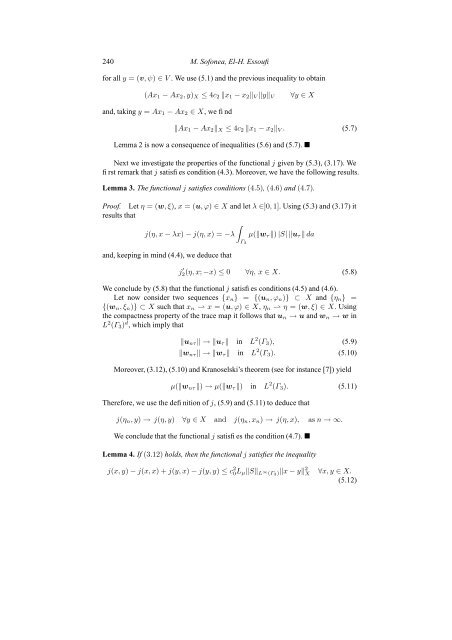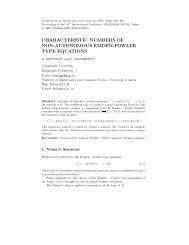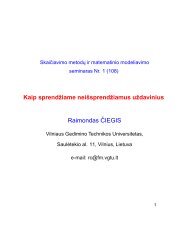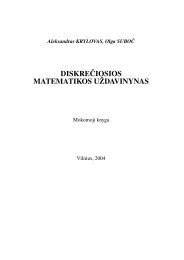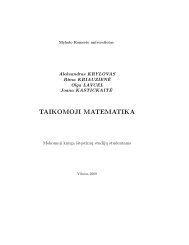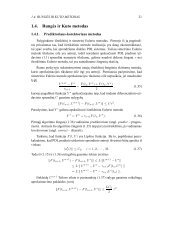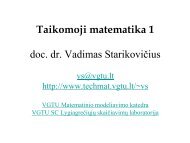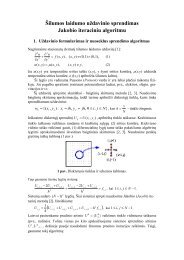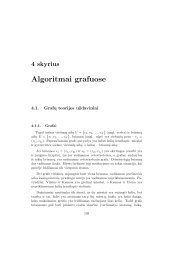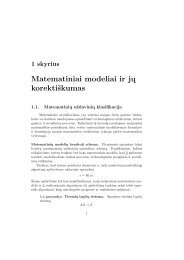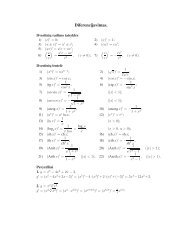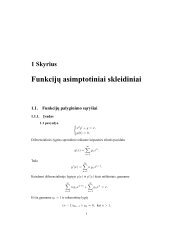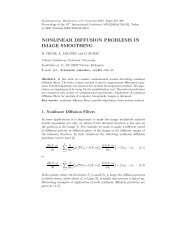240 M. S<strong>of</strong>onea, El-H. Essoufifor all y = (v, ψ) ∈ V . We use (5.1) and the previous inequality to obtain(Ax 1 − Ax 2 , y) X ≤ 4c 2 ‖x 1 − x 2 ‖ V ‖y‖ V∀y ∈ Xand, taking y = Ax 1 − Ax 2 ∈ X, we find‖Ax 1 − Ax 2 ‖ X ≤ 4c 2 ‖x 1 − x 2 ‖ V . (5.7)Lemma 2 is now a consequence <strong>of</strong> inequalities (5.6) and (5.7). Next we investigate the properties <strong>of</strong> the functional j given by (5.3), (3.17). Wefirst remark that j satisfies condition (4.3). Moreover, we have the following results.Lemma 3. The functional j satisfies conditions (4.5), (4.6) and (4.7).Pro<strong>of</strong>. Let η = (w, ξ), x = (u, ϕ) ∈ X and let λ ∈]0, 1]. Using (5.3) and (3.17) itresults that∫j(η, x − λx) − j(η, x) = −λ µ(‖w τ ‖) |S| ‖u τ ‖ daΓ 3and, keeping in mind (4.4), we deduce thatj ′ 2(η, x; −x) ≤ 0 ∀η, x ∈ X. (5.8)We conclude by (5.8) that the functional j satisfies conditions (4.5) and (4.6).Let now consider two sequences {x n } = {(u n , ϕ n )} ⊂ X and {η n } ={(w n , ξ n )} ⊂ X such that x n ⇀ x = (u, ϕ) ∈ X, η n ⇀ η = (w, ξ) ∈ X. Usingthe compactness property <strong>of</strong> the trace map it follows that u n → u and w n → w inL 2 (Γ 3 ) d , which imply that‖u nτ ‖ → ‖u τ ‖ in L 2 (Γ 3 ), (5.9)‖w nτ ‖ → ‖w τ ‖ in L 2 (Γ 3 ). (5.10)Moreover, (3.12), (5.10) and Kranoselski’s theorem (see for instance [7]) yieldµ(‖w nτ ‖) → µ(‖w τ ‖) in L 2 (Γ 3 ). (5.11)Therefore, we use the definition <strong>of</strong> j, (5.9) and (5.11) to deduce thatj(η n , y) → j(η, y) ∀y ∈ X and j(η n , x n ) → j(η, x), as n → ∞.We conclude that the functional j satisfies the condition (4.7). Lemma 4. If (3.12) holds, then the functional j satisfies the inequalityj(x, y) − j(x, x) + j(y, x) − j(y, y) ≤ c 2 0 L µ‖S‖ L∞ (Γ 3)‖x − y‖ 2 X∀x, y ∈ X.(5.12)
A Piezoelectric Contact Problem <strong>with</strong> Slip Dependent Coefficient 241Pro<strong>of</strong>.thatLet x = (u, ϕ), y = (v, ψ) ∈ V . Using (5.3), (3.17) and (3.12) it followsj(x, y) − j(x, x) + j(y, x) − j(y, y)∫= |S| ( µ(‖u τ ‖) − µ(‖v τ ‖) ) (‖v τ ‖ − ‖u τ ‖) daΓ 3∫ ∣ ∫∣∣‖vτ ≤ L µ ‖S‖ L∞ (Γ 3) ‖ − ‖u τ ‖ ∣ 2 da ≤ L µ ‖S‖ L∞ (Γ 3) ‖u − v‖ 2 da.Γ 3 Γ 3Using now (3.3) and (5.1) in the previous inequality we deduce (5.12). We have now all the ingredients to prove the Theorem.Pro<strong>of</strong>. [Pro<strong>of</strong> <strong>of</strong> Theorem 1.]1) Assume that (3.5) – (3.11) hold. Then, Lemmas 2 and 3 allow us to use theabstract results provided by the first part <strong>of</strong> Theorem 2; we obtain that the quasivariationalinequality (5.5) has at least a solution x = (u, ϕ) ∈ X and, using Lemma1,we deduce that (u, ϕ) is a solution to Problem P V , which satisfies u ∈ V , ϕ ∈ W .2) Assume that (3.5) – (3.12) hold and let L 0 =c 2 0 ‖S‖ where c 1 and c 0L ∞ (Γ 3)are defined by (5.6) and (3.3), respectively. Clearly L 0 depends only on Ω, Γ 1 , Γ 3 ,Γ a , F, β and S. Let now assume that L µ < L 0 . Then, there exists α ∈ R suchthat c 2 0L µ ‖S‖ L ∞ (Γ 3) < α < c 1 . Using (5.12) and (5.6) we obtain that the functionalj satisfies condition (4.8). Therefore, by the second part <strong>of</strong> Theorem 2, Lemma 1and (5.4), we obtain that <strong>problem</strong> P V has a unique solution which depends Lipschitzcontinuously on f ∈ V and q ∈ W , which concludes the pro<strong>of</strong>. c 1References[1] R.C. Batra and J.S. Yang. Saint-Venant’s principle in linear <strong>piezoelectric</strong>ity. Journal <strong>of</strong>Elasticity, 38, 209 – 218, 1995.[2] P. Bisenga, F. Lebon and F. Maceri. The unilateral frictional <strong>contact</strong> <strong>of</strong> a <strong>piezoelectric</strong>body <strong>with</strong> a rigid support. In: Contact Mechanics, Kluwer, Dordrecht, 347 – 354, 2002.[3] C. Ciulcu, D. Motreanu and M. S<strong>of</strong>onea. Analysis <strong>of</strong> an elastic <strong>contact</strong> <strong>problem</strong> <strong>with</strong><strong>slip</strong> <strong>dependent</strong> <strong>coefficient</strong> <strong>of</strong> friction. Mathematical Inequalities & Applications, 4, 465– 479, 2001.[4] C. Corneschi, T.-V. Hoarau-Mantel and M. S<strong>of</strong>onea. A quasistatic <strong>contact</strong> <strong>problem</strong> <strong>with</strong><strong>slip</strong> <strong>dependent</strong> <strong>coefficient</strong> <strong>of</strong> friction for elastic materials. Journal <strong>of</strong> Applied Analysis,8, 59 – 80, 2002.[5] G. Duvaut and J.-L. Lions. Inequalities in Mechanics and Physics. Springer-Verlag,Berlin, 1976.[6] I.R. Ionescu and J.-C. Paumier. On the <strong>contact</strong> <strong>problem</strong> <strong>with</strong> <strong>slip</strong> displacement <strong>dependent</strong>friction in elastostatics. Int. J. Engng. Sci., 34, 471 – 491, 1996.[7] O. Kavian. Introduction à la théorie des points critiques et Applications aux équationselliptiques. Springer-Verlag, Paris, Berlin, 1993.[8] F. Léné. Sur les matériaux élastiques à énergie de déformation non quadratique. Journalde Mécanique, 13, 499 – 534, 1974.


